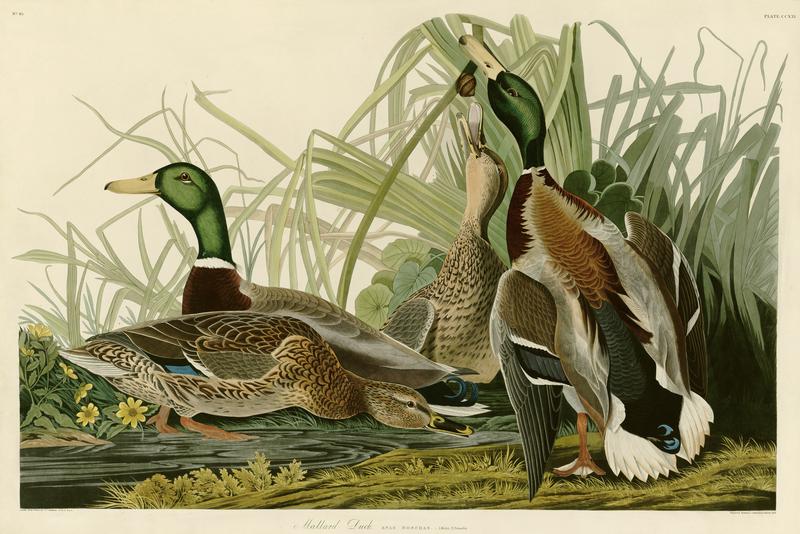John James Audubon: Ecology's Patron Saint
By | August 1, 2019

John James Audubon is a name associated with ecology and conservation. While most people are familiar with his renowned paintings of birds, Audubon’s story is a compelling tale of a self-made, self-reliant immigrant.

Early Life
Audubon was born on April 26, 1785, in the French colony of San Domingue (now Haiti). He was the illegitimate child of Jean Audubon, a sea captain and plantation owner and his chambermaid, Jeanne Rabin, who died shortly after giving birth. The infant took the surname of his mother and was named Jean Rabin.
Jean Audubon sold his holdings on San Domingue in 1791 out of fears of a slave revolt. He returned to Nantes, France where he was raised as a member of the family and even welcomed by Jean Audubon’s wife despite her husband’s infidelities. As the tumults of the French Revolution shook the country, the Audubon’s formally adopted Jean who then took on the family name becoming Jean-Jacques Fougère Audubon. He was schooled in geography, drawing, music, fencing, geography, and mathematics. He was a good student, but even then he showed such a liking for the natural world that it distracted him from his studies. He especially took to drawing birds. Audubon went to the French Naval Academy at Rochfort but was washed out.
Audubon’s father had an estate in Mill Grove, Pennsylvania. As the French Revolution transformed into the despotism of Napoleon Bonaparte, Jean Audubon sent his son across the Atlantic in 1803 in order to avoid conscription.

A Boundless Wilderness
The new United States and its seemingly boundless tracts of the empty wilderness was a dream come true to the young Audubon. He was intensely interested in the natural world. His home swiftly became decorated with all sorts of taxidermy, specimens, eggs, and paintings of birds that he made himself. It was during this time that he tied silver strings around the legs of eastern phoebes to study its migration habits -- he found that they returned to the same nest every year. Thus, Audubon became the first person in North America to practice bird banding.

A Passion
What differentiated Audubon from other naturalists was his desire to see nature in life, particularly birds. During this time, most naturalists shot and stuffed their specimens. So did Audubon, but instead of painting a dead image of a bird, he painted it as it behaved in life. He also painted to lifesize which meant, for example, that when he painted a turkey, he would need to use so-called “double elephant” size paper of 40 by 27 inches. For long-necked birds such as cranes, he needed to bend the subjects into a position so that they would fit on the paper.

Hard Times
In 1808, Audubon married Lucy Blakewell, a neighbor who helped teach him English in exchange for drawing lessons. They moved to Kentucky where they had two sons (there were two daughters who died in infancy). To support the growing family they invested in businesses, a mill and general stores. Wildlife and painting were just a hobby. However, the financial Panic of 1819 ruined the Audubons financially.
Desperate, Audubon looked to his paintings as a source of revenue, either to sell individually or to incorporate into a book. It was generally considered that nobody on the frontier would be interested in buying paintings of wild birds, so he traveled east. In Philadelphia, in 1823 he met Charles-Lucien Bonaparte who was a member of the Academy of Natural Sciences.

Recognition
Bonaparte was the aristocratic nephew of the now-deceased Emperor Napoleon and was said to closely resemble him. He had a passion for nature similar to Audubon and was awed by the artwork. In a whirlwind Audubon was introduced to artists and members of Academy of Natural Sciences. He was put up to be elected as a member, but he was rejected because of criticisms he made against a respected, deceased ornithologist.

Birds of America
However, Audubon did have supporters and they encouraged him to find a publisher in Europe. In London, Audubon’s frontiersman personal and his art was spectacularly received. In 1826 the first of his engravings for Birds of America was produced and work continued for the next dozen years. When the final volume of the seminal work was finished and its accompanying text, Ornithological Biography, Audubon was 54 years old. There were some 435 plates of his birds in the work.
Audubon spent his last years afflicted with senility and died in 1851 at age 65. The coppers used for the engravings were bequeathed to his wife. Many of these were damaged and she tried to auction them off before selling them for scrap. Of these, less than 80 survive as the original work of one of the great artists of nature.

Legacy
The National Audubon Society notes that they took their namesake because “Audubon’s story is one of triumph over adversity; his accomplishment is destined for the ages. He encapsulates the spirit of young America when the wilderness was limitless and beguiling. He was a person of legendary strength and endurance, as well as a keen observer of birds and nature. Like his peers, he was an avid hunter, and he also had a deep appreciation and concern for conservation; in his later writings, he sounded the alarm about the destruction of birds and habitats. It is fitting that today we carry his name and legacy into the future.”

